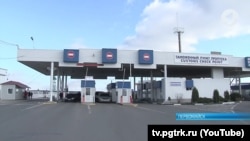On Jan. 14, a news report on the main television channel in the Transnistria region of Moldova claimed that cars licensed from the breakaway area wouldn’t be allowed across the Ukrainian-Moldovan border.
Transnistria is a Russian-leaning region of Moldova that’s been agitating for independence since the demise of the Soviet Union. A brief military conflict in 1992 ended in a ceasefire. Most countries – even Russia – haven’t recognized Transnistria, but the political skirmishing continues.
In this case, over license plates.
Moldova and the unrecognized “Transnistrian Moldovan Republic” both issue license plates, a situation that created potential confusion at the borders.
In September 2018, however, the competing sides agreed to a compromise: neutral license plates, with three numbers and three letters. Moldova allowed cars with neutral plates to cross the Ukraine border unhindered.
This is where First Transnistria comes in. The channel is financed and controlled by a Transnistrian governmental administration in Tiraspol that, among other things, collects taxes and maintains a paramilitary security force.
The headline and intro of the TV report said that all cars, including those with neutral plates or numbers with Moldovan state symbols officially issued in the capital of Chisinau, would not be able to leave Transnistrian territory.
That was false.
In fact, officials in Chisinau said they had only begun a temporary program to stop allowing cars with Transnistrian plates into Ukraine, as had been the practice.
“On January 10 of the current year, the exclusive border crossing procedure, under which vehicles registered by the organs of Transnistria were allowed to cross the Moldovan-Ukrainian border, was suspended,” an official statement of the Republic Reintegration Bureau Moldova said.
The statement said the goal, in part, was to “inform citizens about the need to properly register their cars and obtain ‘neutral’ license plates.”
Alexander Flenkya, the Moldovan deputy premier for reintegration, issued a similar statement on Facebook 10 days later.
Some said the First Transnistrian report was aimed at creating hostility toward the Moldovan government.
“In this news, we see the manipulation of several levels,” said political analyst Andrei Andrievsky.
“This is a lie – those who have the documents and ‘neutral plates’ in order are not affected by the innovation of the Moldovan authorities.”
Andrievsky suggested there was a “deeper level of manipulation” in the report aimed at perpetuating the notion that Transnistria is a distinct nationality.
Ruslan Shevchenko, a historian, noted that the term “Transnistrians” in the report is disputed by the Chisinau government. In this case, he said, the story stokes resentment that Moldova is unjustly restricting freedom of movement.
In response to Chisinau’s measure, the authorities in Tiraspol passed “reciprocal measures” that banned drivers licensed by Moldova in cars with Moldovan plates from entering Ukraine via the Transnistrian border. The decision was taken by the local authorities’ Security Council on Jan. 17 and went into effect on Jan. 24.
All the travel restrictions have since expired so that drivers from Transnistria with all types off plates can cross the Ukraine border without problems.





